Master the Art of Maximizing Space: How to Organize a Small Nursery
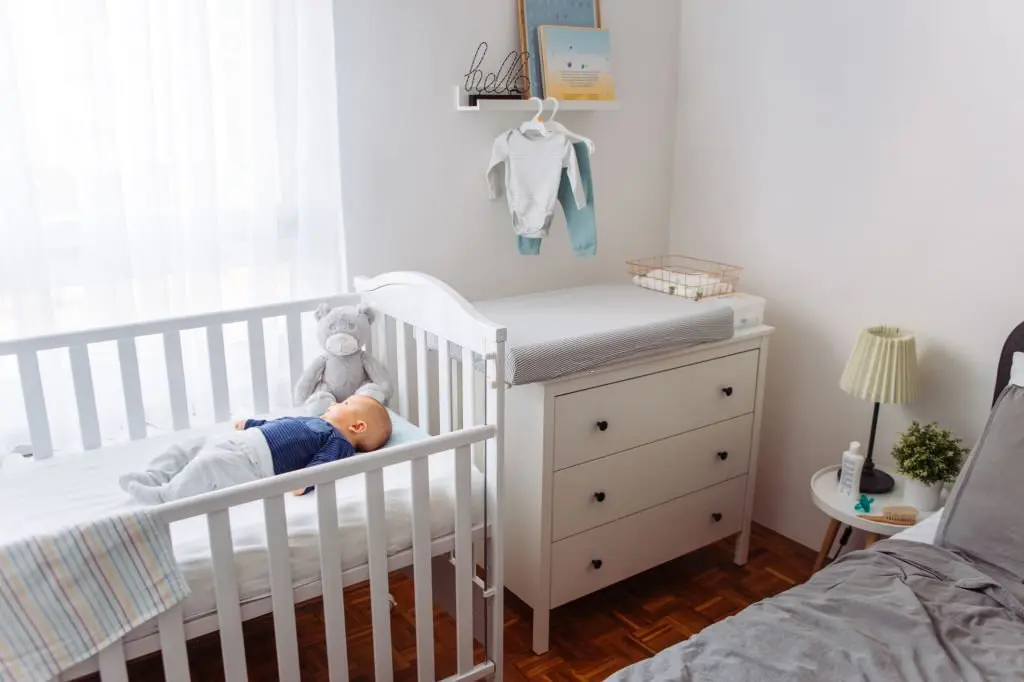
Introduction to how to organize a small nursery
First, take a deep breath and sigh in relief. Your worries about arranging the perfect nursery in a smaller space are about to disappear. We’re stepping in with ingenious tips and creative solutions to help you learn how to organize a small nursery.
Though you might feel like you’re solving a complex puzzle right now, remember that every challenge also presents an opportunity to think outside the box. A small nursery doesn’t mean compromising on style or functionality. With smart planning, it can be a cozy, well-organized, and delightful haven for your little one.
How to get a small nursery organized
Understand your space
Start with a thorough analysis of the nursery space. Measure the room’s dimensions, noting the length, width, and height. Pay attention to the placement of doors and windows, electrical outlets, and light fixtures.
Also, consider the natural light entering the room and any architectural quirks. This initial assessment provides a clear picture of the playground you’re working with and allows for strategic furniture arrangement and storage planning.
Choosing multi-functional furniture
Choose a crib that fills different roles.
One crucial strategy when organizing a small nursery is choosing multi-purpose furniture. A crib that also provides storage space is a smart choice for smaller nurseries.
It serves as a comfortable sleeping space for your baby and also doubles as a storage hub for your baby’s essentials. This saves precious floor space and keeps everything you need within arm’s reach.
Efficient use of available spaces
Use the space under the crib.

Now, let’s look at the “hidden” storage spots in the nursery. An often-overlooked storage space is underneath the crib.
Flat, roll-out storage boxes can seamlessly fit under the crib, providing ample room to stash away items that aren’t needed daily. Think of baby blankets, spare linens, or even out-of-season clothing. It’s all about making every square inch count!
Use the nursery dresser.
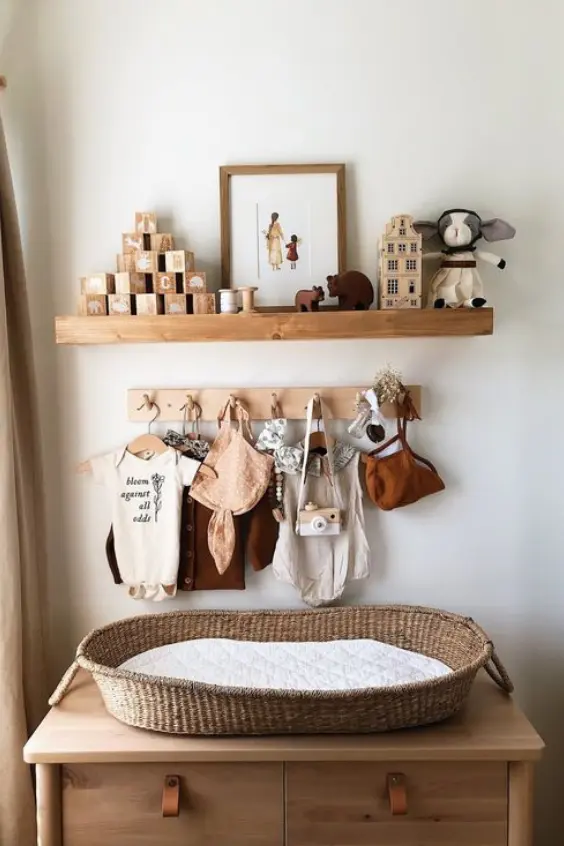
When space is at a premium, it’s time to think vertically. The wall space above your dresser or changing table is prime real estate for storage.
Install a couple of floating shelves here, and voila! You’ve got a perfect place to keep baby books, plush toys, or beautiful keepsakes. Plus, it adds a touch of charm to the nursery décor.
Creative storage solutions
Turn shelves into a wardrobe.
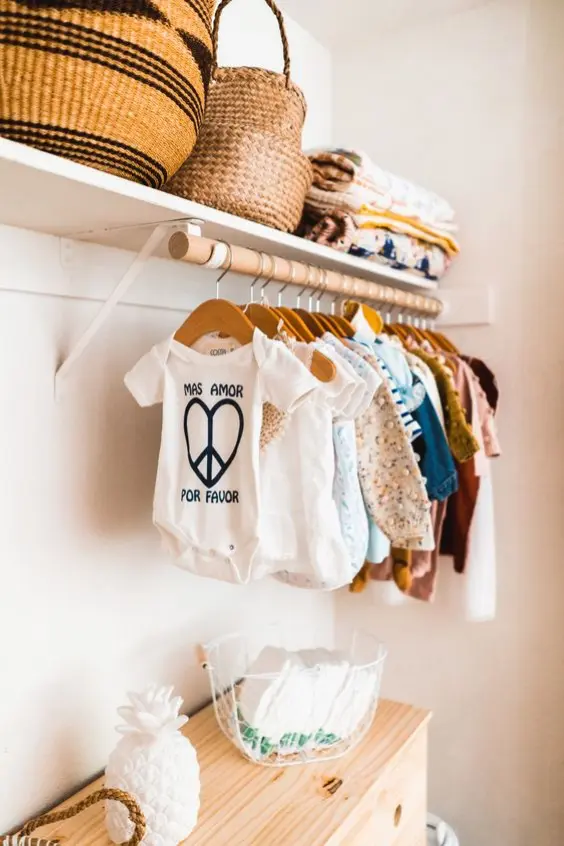
What do you do when there’s no space for a traditional wardrobe? Well, you improvise! You can install sturdy shelves on the wall with a hanging rod beneath. Use the rod for hanging baby’s outfits, while the shelves can accommodate cute storage baskets for diapers, towels, and other baby essentials.
Hang-over-the-door storage
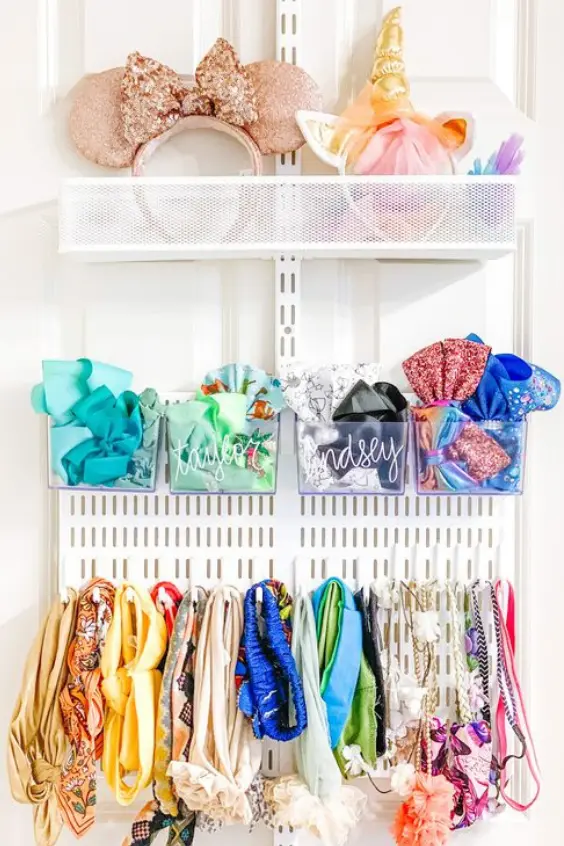
The door isn’t just an entry point; it’s also a potential storage spot. An over-the-door organizer with multiple pockets can store various small items, from cute little socks to baby hats and bibs. This way, you’re using every bit of available space without making the room feel cluttered.
Baskets with labels

Baskets are your best friends when organizing a small nursery. They’re perfect for organizing items on shelves, under the crib, or even on the floor. Plus, attaching labels to the baskets keeps everything in its place and makes it easy to find what you need in a jiffy.
Get wall hooks
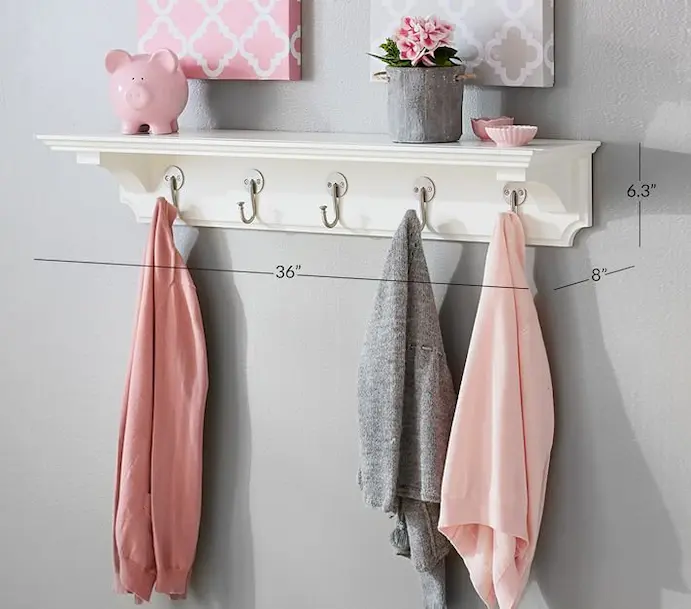
Wall hooks are a small nursery’s secret weapon. Strategically placed, they can be used to hang baby jackets, towels, diaper bags, or even tomorrow’s cute outfit. Apart from serving as a practical storage solution, they can also add a whimsical touch to your nursery décor.
Install a rod under the shelf.
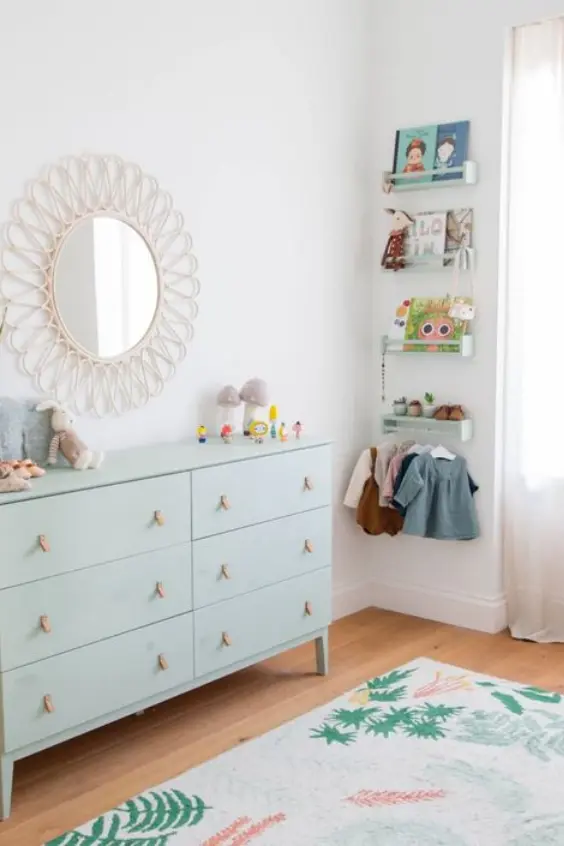
Think of the space under the shelf as your mini storage unit. You can hang S-hooks or small baskets by installing a rod here, offering additional storage for soft toys, pacifiers, or baby accessories.
Consider a headband holder.
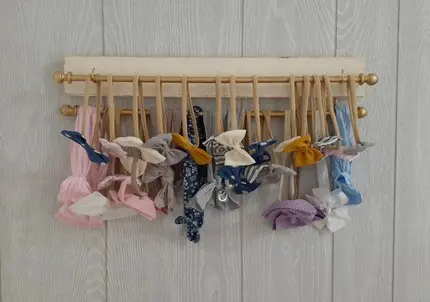
If you’re blessed with a baby girl and her collection of headbands is growing, consider a headband holder. This DIY project can add a personal touch to the nursery and helps keep those adorable headbands organized and easily accessible.
Small item organization
Nursery drawer organizers for organizing the dresser

Drawer organizers are your go-to solution when organizing smaller items like baby socks, mittens, or diapers. They can help compartmentalize the drawers in your dresser, keeping everything neatly sorted and preventing the dreaded “jumbled drawer syndrome.”
Bring in a rolling cart.
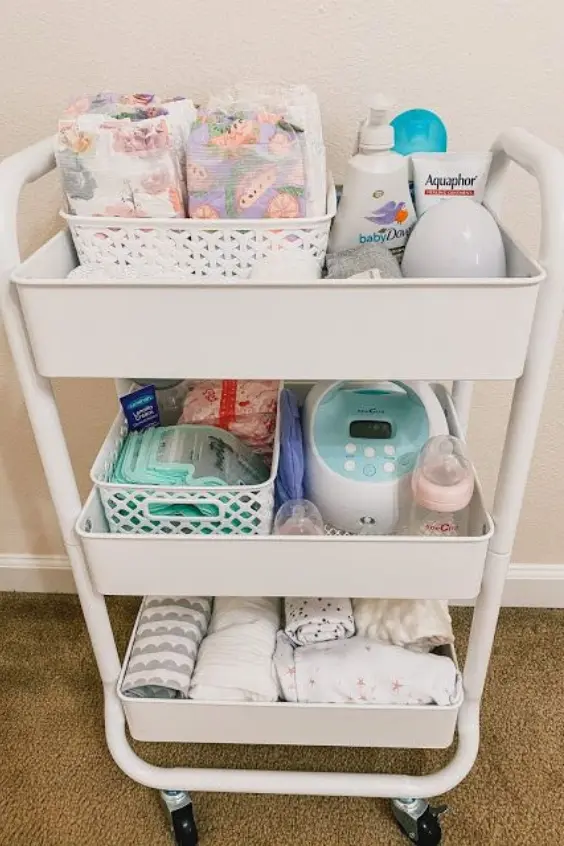
A rolling cart is like your personal assistant in the nursery. It offers movable storage space and can be used to stash toys, books, or diaper-changing essentials. Need to free up some space for playtime? Just roll the cart out of the room. It’s that simple!
Conclusion on how to Organize a Small Nursery
A small nursery doesn’t mean you need to compromise on style, functionality, or organization. You can create a warm, welcoming, and well-organized nursery for your little one with the right approach and creative solutions.
After all, the size of the room isn’t what matters most, but the love and care that fills it. So get creative, have fun with the process, and you’ll create a perfect little haven that your baby will adore.
Also Read:
- 17 Best Nursery Dresser Changing Tables of 2023
- Bedroom Nursery Tips: How to Set up a Nursery In Your Bedroom
- Baby’s Nursery Organization: How to set up nursery furniture
- How to Organize a Baby Dresser: Tips and Tricks
FAQs on how to organize a small nursery
Can I use regular furniture in a nursery?
Absolutely! But it’s important to ensure it’s baby-friendly. Always opt for furniture with rounded corners and a stable design that won’t tip over easily.
How can I keep the nursery clutter-free?
Regularly decluttering and sorting out items is key. Keep only what you need and use it regularly. Rotate toys and clothes as your baby grows, and use labeled storage to keep everything organized and easy to find.
Is a changing table necessary?
It depends on your preference and available space. If you’re short on space, a changing pad that can be securely placed on top of a dresser can be a great space-saving solution.
Can I use a closet as a nursery?
Yes, you can! You can transform a closet into a cozy, functional nursery space with creative organization and design ideas.
How can I make a small nursery feel bigger?
Opt for light colors to reflect light, add mirrors to create the illusion of more space, and ensure the room is well-lit. Keep the room well-organized to avoid a cluttered look.
What are some good storage items for a small nursery?
Over-the-door organizers, labeled baskets, floating shelves, and under-bed storage boxes are all excellent storage solutions for a small nursery. Each of these items can help maximize the available space and keep things neat and organized.
How do I start planning a nursery?
Planning a nursery starts with identifying the space available and understanding your needs. Once you have that figured out, consider the following steps:
Choose a theme or color scheme: It could be something you love or perhaps a theme that grows with your child.
Select the essential furniture: The basic essentials for a nursery are a crib, a changing station, and storage for baby essentials. Remember to consider the size and scale of the furniture that best suits your nursery.
Plan for storage: Babies come with a lot of stuff! Clothes, diapers, toys, and books. Think about where you will store these items and how you can do so in an organized way.
Consider the lighting: Ensure there’s adequate lighting for various needs – a bright main light for playtime, a soft light for nursing or changing diapers, and a nightlight for the evenings.
Safety is paramount: Make sure all furniture and decorations are safe for the baby. This means securing furniture to the wall, avoiding long cords, and making sure small objects are out of reach.
Personalize it: Add elements that make the room special – this could be framed pictures, a beautiful rug, or handmade items from loved ones.
How do you maximize storage in a small nursery?
Maximizing storage in a small nursery is all about being creative and making every square inch count. Here are some ideas:
Use multi-functional furniture: Opt for a crib with built-in drawers, a changing table with shelves, or a dresser.
Go vertical: Install shelves on the walls to store and display toys, books, or decor items.
Under-bed storage: Use flat, sliding boxes under the crib to store less frequently used items.
Door organizer: Hang an over-the-door organizer to keep small items.
Use baskets and bins: Baskets, bins, or decorative boxes can be used on shelves, under the crib, or inside the closet to store toys, blankets, or clothes.
How should a nursery be set up?
Setting up a nursery involves a few important steps:
Position the crib safely: The crib should be placed away from windows, heaters, lamps, wall decorations, and cords.
Plan for easy access. Arrange your changing station, dresser, and crib to make it easy to move from one task to another.
Create a cozy feeding spot: Whether you’re breastfeeding or bottle-feeding, you’ll want a comfortable place to sit with your baby.
Think about lighting: It’s helpful to have a main light for general illumination, a reading light for story time, and a soft light for late-night feedings.
Organize with your baby’s needs in mind: Keep the most frequently used items at arm’s reach. This usually means diapers, wipes, burp cloths, and pacifiers.
What do you need in a small nursery?
Even in a small nursery, certain essentials are needed to ensure your baby’s comfort and safety:
A crib or bassinet: This is obviously a must-have for the nursery. A crib with built-in storage can be a lifesaver for a small room.
Changing area: This could be a traditional changing table, or a changing pad that can be put on top of a dresser works great for smaller spaces.
Storage: Consider shelving, drawers, bins, and baskets to organize clothes, diapers, toys, and books.
Seating: You’ll need a comfortable place to sit while feeding or rocking your baby to sleep.
Lighting: A combination of overhead lighting and a softer lamp or nightlight works best.
Decor: Even though it’s a small room, adding personal touches makes the space special. This could be a beautiful wall decal, a mobile, or framed pictures.
Can I fit a rocking chair in a small nursery?
Certainly! Look for a compact rocking chair, or consider a foldable one. Remember, comfort for you is important too.
